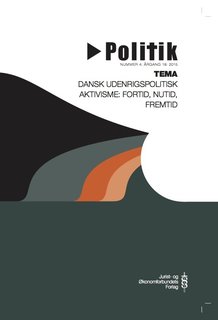Prioritering, profilering og politisk orientering. Engagement og aktivisme i dansk udviklings- og bistandspolitik 1962-2015
DOI:
https://doi.org/10.7146/politik.v18i4.27625Resumé
Since the late 1970s Denmark has persistently belonged to the small group of states honouring the UN goal for rich countries to donate at least 0,7 per cent of GNP yearly in o cial development aid. is approach has allowed Denmark to pursue an activist policy both multilaterally within international development institutions such as the World Bank, DAC, UNDP, etc. and bilaterally in relation to development countries where Danida, the central Danish aid organization, has been active. Development aid activism and inter- nationalism reached a zenith in the decade after the fall of the Berlin wall when Danish ODA passed the 1 per cent threshold and when the aid component under the heading of „active multilateralism“ was sought integrated into all dimensions of Danish foreign policy. is trend was reversed in the period after 2001 when the Liberal Fogh Rasmussen government took o ce backed by the development aid sceptics in the Danish People’s Party. Critics even maintain that Danish development has seen change resembling a paradigm shift in the post-2001 period. e problem, however, is complex and therefore, on the basis of an analysis of the prioritizing, the orientation and the international pro ling of Danish development aid, this article seeks to disentangle and discuss continuities and break in the role of development aid in Danish foreign policy since the adoption of the rst Danish development aid law in 1962.
Downloads
Publiceret
Citation/Eksport
Nummer
Sektion
Licens
Forfattere, der publicerer deres værker via dette tidsskrift, accepterer følgende vilkår:
- Forfattere bevarer deres ophavsret og giver tidsskriftet ret til første publicering, samtidigt med at værket er omfattet af en Creative Commons Attribution-licens, der giver andre ret til at dele værket med en anerkendelse af værkets forfatter og første publicering i nærværende tidsskrift.
- Forfattere kan indgå flere separate kontraktlige aftaler om ikke-eksklusiv distribution af tidsskriftets publicerede version af værket (f.eks. sende det til et institutionslager eller udgive det i en bog), med en anerkendelse af værkets første publicering i nærværende tidsskrift.
- Forfattere har ret til og opfordres til at publicere deres værker online (f.eks. i institutionslagre eller på deres websted) forud for og under manuskriptprocessen, da dette kan føre til produktive udvekslinger, samt tidligere og større citater fra publicerede værker (se The Effect of Open Access).

